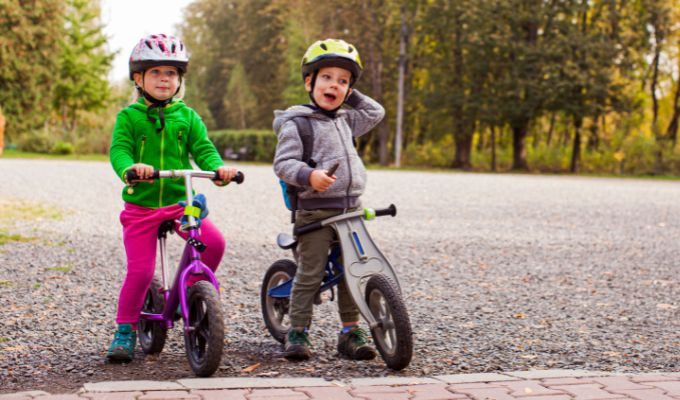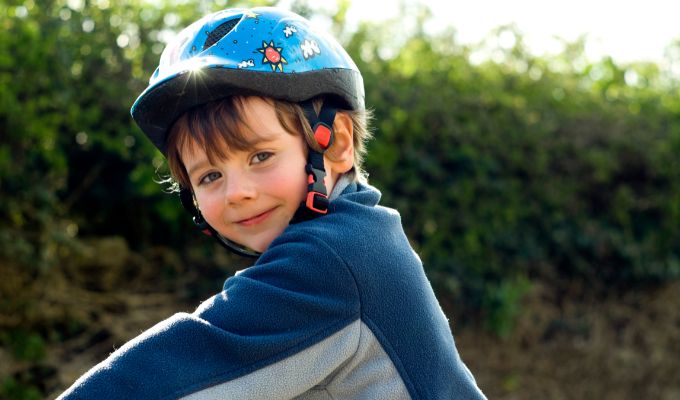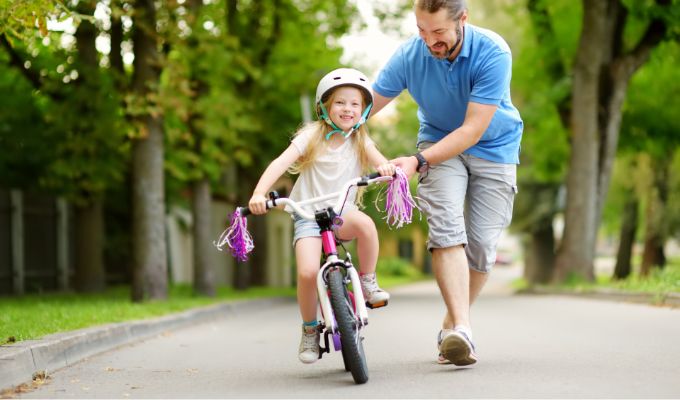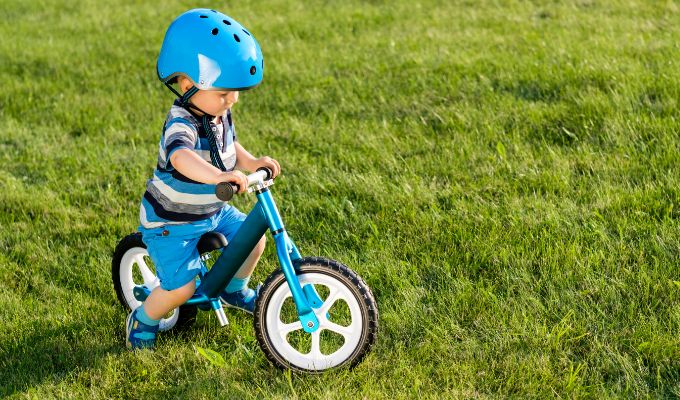Little ones are always on the go. They love to explore their surroundings actively. Crawling and clambering around the home, eventually pulling themselves up, and learning to balance and walk.
We all start life off as helpless little bungles, moved around in a pram or buggy. After using a walker, our first vehicle of independence is usually a bicycle.
Of course, 2 year old are still some time away from riding around on a chain-driven bike. But parents can play a big role in assisting their kids in following this path to cycling by investing in a children’s balance bike.
Based on user reviews, ratings, and other qualitative factors, like handling and safety, we have round-up the top four balance bikes for 2-year-old child.
Strider 12 Sport Balance Bike For Ages 18 Months+
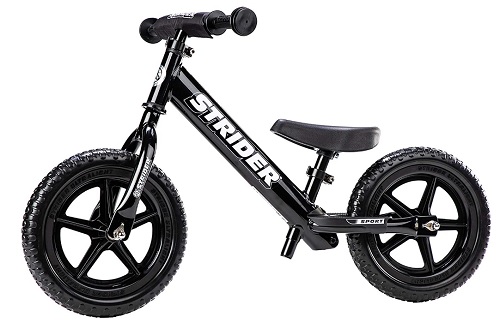
The Strider 12 Sport Bike has a lightweight steel frame, weighing just 2.5kg, that can withstand even the roughest treatment from your toddler, and its puncture-proof Foam Rubber Tires ensure that you’ll never have to worry about the cries of a flat tyre.
Forget messy chains and wheel oils with maintenance-free wheel bearings. It’s designed for pure fun, which means no maintenance, punctures, or bits falling off – ready for whatever kids can throw at it.
Every detail of this bike, from the robust frame, and dimensions, down to the kid-friendly hand grips was designed perfectly for active kids.
Fully adjustable seat and handlebar hight, so the bike grows with your child. Unlike your kids growing out of their clothes, it’s hard to keep up, this balance bike can be adjusted as they grow, for years of use. Available in black, green, orange, pink, and red, to suit girls and boys who are picky about colours.
Bikestar Lightweight Kids First Running Balance Bike with brakes
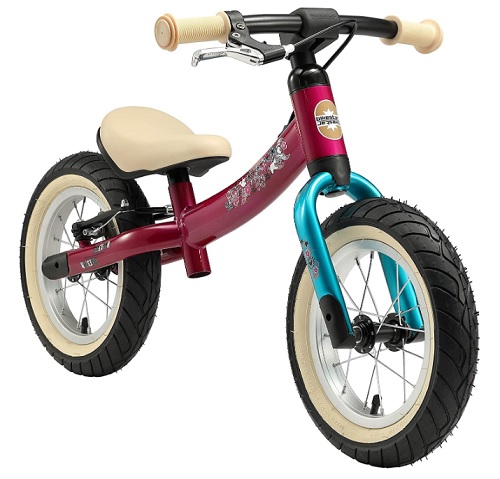
The comfortable saddle and the 12-inch air tyres will make for a smooth ride, even over rough terrain. Thanks to the high-quality steel and rigid frame, this little bike can handle the hardest knocks and bumps without damage.
No need for stabilisers. A child’s innate ability to maintain balance is fostered by the handling of the Bike Star balancing bike, making the transition to a traditional bike a breeze down the road.
This balance bike teaches kids the freedom and responsibility of independent movement. They won’t misss their old strollers or buggies, experiencing firsthand the joy of independence for the first time.
You’re in good hands – for over 10 years, the BIKESTAR brand has fostered our nation’s younger generation’s intellectual and physical growth by encouraging a love of exploration and discovery.
Every year, Bike Star products win the hearts of thousands of children – join the family. We’re well aware, as parents, that kids tend to put new toys through hash testing, which is why the frame of our balancing bike is made out of solid steel with secure welds and bolts.
After a decade in the market, BIKESTAR has been synonymous with innovative product design that appeals to a wide audience, not just kids. The Munich, Germany, company today has one of the greatest selections of children’s vehicles in all of Europe because of the success of its BIKESTAR and STAR-SCOOTER brands. This bike comes in a wide range of exciting colour combinations and has a break lever.
Next: Best Bike Helmet for Balance Bike (2 – 4 year old)
Chillafish Charlie 10″ Balance Bike
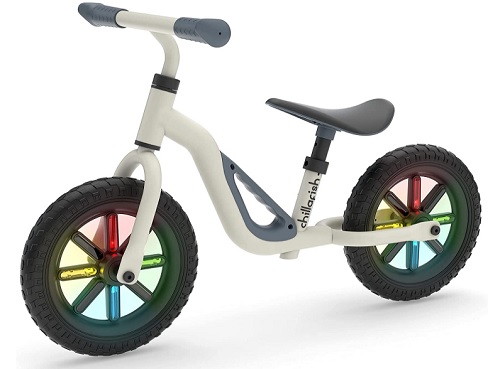
Perfect for developing your child’s motor skills, balance, coordination, and steering, the Charlie is a 10″ balance trainer with puncture-proof tyres and a high-quality metal frame that weighs just over 2kg is a superb little balance bike for 2 – 4-year-olds.
It comes in a wide combination of colours, from neutral brown and black, to vibrant pink, and coloured spokes. You girl or boy is sure to find their favourite colour comb to hit the road.
Both the specially moulded comfort seat adjusts from 28 at the shortest, to 37cm at the tallest setting, and the handlebar is height adjustable from 48 to 51cm so when your child grows, the bike can be adjusted too.
Your child will have no trouble steering this bike, and its lightweight construction will make it convenient for you to transport it from place to place without much effort.
The 10-inch EVA tyres on the Charlie balancing bike are incredibly comfy, and they don’t need to be inflated, so your kids can learn to ride a real bike with no time wasted worrying about punctures from riding over broken glass or jagged stones.
Kinderkraft Wooden Balance Bike
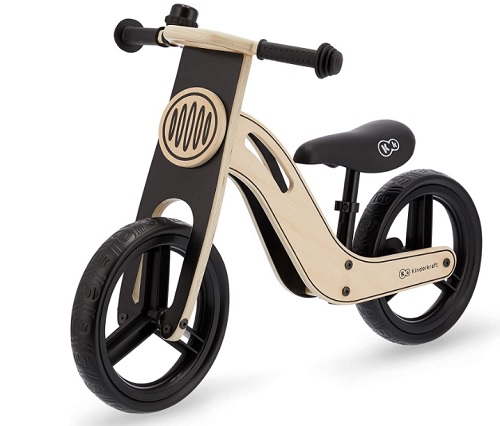
Every infant will enjoy riding on this natural light, fully adjustable, wooden balancing bike. The bike will immediately become your toddler’s favourite playmate thanks to its unique style and adorable graphic on the front and is the perfect bring-along for long walks.
UNIQ can be used by kids as young as 2 years old, weighing up to 35kg. It helps toddlers develop stronger muscles in a fun way, by enhancing their motor skills and coordination when riding. They learn to maintain their balance and get ready to ride a bigger bike with peddle while skipping stabiliser wheels.
It has been independently tested and found to be safe by the Intertek laboratory, and its design follows the most recent safety standard EN71-1. Long-distance testing was also performed by TÜV Rheinland on the finalised design. It also has a handlebar lock to keep a young rider from wildly rotating the wheels. The bike’s seat may be adjusted in height from 30 to 40 cm, making it suitable for infants of varying sizes.
An ergonomic handlebar and nonslip grips make riding the UNIQ a breeze. Parents will appreciate the stroller’s portability, thanks to its compact lightweight design and two carry handles (one on the frame and one on the handlebar). You can’t go wrong with UNIQ bikes on pavements, trails, gardens, or parks. The wheels are constructed of a special, puncture-proof grippy foam tread.
Why should a child learn to ride a balance bike?
A child must learn to preserve their balance above all else in order to ride a balance bike safely. Although it takes time, training is essential if you later wish to ride a bike. Balance is crucial once again in this situation.
The kids also improve their motor skills and build up their leg muscles, which are two additional aspects that are crucial for cycling.
However, it makes less sense among experts to do without the balance bike and instead first mount training wheels on the bike. This is because the sense of balance is not promoted.
At what age does a balance bike make sense?
The subject of when a child is “grown” enough for a balance bike has no universally accepted answer. The age range of two to three years should only be used as a general guide. Many kids start using two wheels at age one and a half, while others don’t until much later.
The child’s individual growth is far more crucial. What size is it? How about his motor abilities? Unquestionably, a requirement should be secure standing and walking.
Children under two are also not mentally mature enough to process the various impressions of road traffic. Therefore, you should only use the balancing bike away from traffic to practise.
Riding balancing bikes may be a lot of fun for older kids who are closer to primary school age. Parents shouldn’t encourage their children to ride bikes if they aren’t yet interested in doing so. The need to “climb” typically strikes suddenly, unpredictably, and all by itself.
What size should the bike be?
Wheels come in a variety of sizes, with 10 or 12-inch wheels being the most popular. There are different models with 8-inch wheels or larger wheels. Parents should prioritise taking a close look when choosing the best balance bike for their child.
Because the child’s balance bike’s proper seat is the deciding aspect. Its feet should be fully planted on the earth, both of them. Legs are still a little bowed. The bike’s saddle is positioned in its lowest seating position for this test. The parents should measure the children’s steps again to double-check.
Generally speaking, there should be at least two centimetres between the inseam and saddle height. In general, bikes with adjustable saddles and handlebars are advised; a low entry makes getting on and off the bike simpler.
How does a child learn to ride a balance bike?
It is advised to pick a surface that is as flat and free of other road users as possible for the initial wheel trials. However, parents shouldn’t anticipate that their child will start riding right away. It is entirely OK to “test sit” or even push the new vehicle comfortably. The same rule applies here: Be careful! The child will eventually learn on their own the optimal way to push off in order to move forward.
What types of wheels are there?
There are distinctions, as was already indicated, particularly in size. Commercially, variations starting at 8 inches and up are offered.
Parents can choose from three different materials: metal, wood, or plastic, with metal and wood being the most popular. A lot of this is primarily a matter of preference.
But there are variations in terms of weight. For instance, metal wheels are frequently heavier than wooden ones. This is also apparent in how things are handled.
Here, parents should consider their child’s constitution while weighing the purchase. Metal wheels, in contrast, excel due to their weather resistance, which is important for anyone who frequently puts their wheels outside.
Along with the traditional balancing bikes, there are a number of unique types that literally grow with the kids and are distinguished by a very long service life.
A children’s tricycle, for instance, can be converted into a balancing bike later on. There are additional models on the market that can be changed from a balance bike to a bicycle.
The bikes are then appropriate as a basic model for kids up to the age of six or seven. However, parents should pay attention to the size and weight of the combo model, particularly with the latter types.
What about the tires on the children’s balance bike?
There is essentially a distinction between air-filled tyres and solid rubber or plastic tyres when it comes to wheels.
Air-filled tyres, like those on bicycles, offer more pleasant suspension but are thought to be more prone to punctures.
Tires made of plastic or solid rubber are far more durable. However, they do have the drawback of maybe being more unpleasant when hiking on uneven terrain.
What accessories are there for a balance bike?
Balance bikes can also be equipped with some add-ons or accessories. There are wheels with and without brakes, for instance.
When parents initially believe that their child will be safer if the balance bike has a handbrake, they frequently feel secure. However, that is only partially true. Particularly young toddlers under the age of two typically lack the motor skills necessary to operate a handbrake correctly, let alone when and how to apply the braking system.
The handbrake will be more appreciated by older kids who have used their balance bike for a while. This is especially true if you’re about to convert to cycling.
The installation of a side stand falls under this as well. Instead of merely leaving their possessions on the floor, it might teach kids to take care of them.
Lighting is not strictly necessary because kids who are old enough to ride balance bikes rarely venture outside after dark. Of course, there is nothing wrong with fitting the bike with a front and backlight to follow in the footsteps of the “big ones.”
Children simply enjoy silly extras like pendants or tiny bags for their favourite cuddly toy, which also makes using the balance bike more enjoyable.
When taking their children on outings, parents should opt for peaceful paths and streets so that the youngster feels comfortable and is not overly preoccupied.
Downhill roads can be hazardous as well, especially if the bike lacks brakes or if the rider is too young to operate them safely.
Additional protection is provided and the risk of harm is reduced thanks to safety grips and padding on the handlebars.
The restriction of steering angle is a hot topic. This indicates that the handlebars on these wheels can only travel so far.
More stability is mentioned by supporters, particularly in sharp turns.
In the eyes of opponents, there is a higher risk of harm if the youngster should fall onto the upward-facing handlebars.
Warning: Always supervise a child riding a balance bike – keep them within arm’s reach. Never ride on the road or next to live traffic.
In this case, parents should make their own choices.
Balance Bike Buying Checklist
When does a balance bike make sense? This question has to be answered individually. Children between the ages of 1.5 and 2 are usually motorically ready to use a balance bike. Only when your children are ready enough with their sense of balance to move on it will they have fun with a balance bike.
Size: The saddle of the balance bike should be at a height where your child can still step firmly on the ground with their feet. We, therefore, recommend bikes with height-adjustable saddle and handlebars. The step height should be slightly (approx. 2 fingers wide) higher than the seat height.
Material: Most balance bicycles are made of wood, plastic, or metal. Models with wooden frames are lighter but not as durable or weatherproof. Models with a metal frame, on the other hand, are more durable and also more stable due to their higher weight.
Tires: The tires on a wheel contribute a lot to the stability and handling. Wider tires are significantly more stable and give a more secure feeling. In addition, different materials are used. A distinction is made between models with rubber, plastic, foam, and air-filled tires.
Although rubber and plastic wheels are maintenance-free because they don’t require air inflation, and can’t burst, they do not offer the same driving comfort as air-filled tires. The best grip, however, is air-filled tires that are covered with a rubber cover like bicycle tires. However, since rubber tires usually combine the advantages of both types, they are a suitable compromise.
